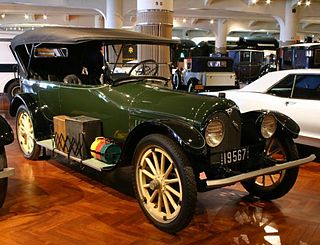
The Apperson was a brand of American automobile manufactured from 1901 to 1926 in Kokomo, Indiana.

The gasoline-powered Oldsmobile Model R, also known as the Curved Dash Oldsmobile, is credited as being the first mass-produced automobile, meaning that it was built on an assembly line using interchangeable parts. It was introduced by the Oldsmobile company in 1901 and produced through 1903; 425 were produced the first year, 2,500 in 1902, and over 19,000 were built in all. When General Motors assumed operations from Ransom E. Olds on November 12, 1908, GM introduced the Oldsmobile Model 20, which was the 1908 Buick Model 10 with a stretched wheelbase and minor exterior changes.

Buffalo Electric Carriage Company was a Brass Era manufacturer of electric automobiles in Buffalo, New York.
The Courier was a brass era car manufactured by Sandusky Automobile Company in Sandusky, Ohio in 1904 and 1905.

B. V. Covert and Company was a manufacturer of automobiles in Lockport, New York, from 1901 to 1907. The company started as a manufacturer of steam-powered cars, but later switched to gas-powered vehicles. Some Coverts were exported to England as Covert-Jacksons.

Crest Manufacturing Company was a manufacturer of automobiles in Cambridge, Massachusetts. They built cars between 1901 and 1904.
Duryea Power Company was a manufacturer of Brass Era automobiles in Reading, Pennsylvania. It was one of several similarly named companies that early automobile pioneer Charles Duryea was involved with.

Elmore Manufacturing Company was a manufacturer of veteran and brass era automobiles and bicycles (1893–97), headquartered at 504 Amanda Street, Clyde, Ohio, from 1893 until 1912. The company took its name from a small parcel of land in Clyde with the name Elmore associated with it where a stave mill was established originally, then evolved into bicycle production. The village of Elmore, Ohio is located 20 mi (32.2 km) to the east. Founded by Harmon Von Vechten Becker and his two sons, James and Burton, the Elmore used a two-stroke engine design, in straight twin or single-cylinder versions. They later produced a straight-3 followed by a straight-4 beginning in 1906 until production ended in 1912. The company advertising slogan was "The Car That Has No Valves", referring to the two-stroke engine.
Fredonia Manufacturing Company was a manufacturer of automobiles in Youngstown, Ohio, United States.

Grout Brothers was a manufacturer of steam-powered automobiles in Orange, Massachusetts. The three brothers, Carl, Fred and C.B. were set up in business by their father William L., who had made sewing machines under the New Home name in partnership with Thomas H. White. The early cars were sold under the New Home name.

Haynes-Apperson Company was a manufacturer of Brass Era automobiles in Kokomo, Indiana, from 1896 to 1905. It was the first automobile manufacturer in Indiana, and among the first in the United States. Elwood Haynes, one of the founders, worked on early types of stainless steel and was the inventor of stellite, and many of the early advances in automobile technology were first invented by the company.

The Robinson and later Pope-Robinson was part of the Pope automobile group of companies founded by Colonel Albert Pope manufacturing Veteran and Brass Era automobiles in Hyde Park, Massachusetts.

Pope-Waverley was one of the marques of the Pope Motor Car Company founded by Albert Augustus Pope and was a manufacturer of Brass Era electric automobiles in Indianapolis, Indiana. From 1908 until production ceased in 1914 they became independent again as the Waverley Company.

E. R. Thomas Motor Company was a manufacturer of motorized bicycles, motorized tricycles, motorcycles, and automobiles in Buffalo, New York between 1900 and 1919.
Wilson Automobile Manufacturing Company was a manufacturer of automobiles in Wilson, New York between 1903 and 1905. Their automobile model was sold as the Niagara.

The Yale was an automobile by the Kirk Manufacturing Company, a manufacturer of Brass Era automobiles in Toledo, Ohio, from 1901 to 1905.

The first Cadillac automobiles were the 1903 Model built in the last quarter of 1902. These were 2-seater "horseless carriages" powered by a reliable and sturdy 10 hp (7 kW) single-cylinder engine developed by Alanson Partridge Brush and built by Leland and Faulconer Manufacturing Company of Detroit, of which Henry Leland was founder, vice-president and general manager.

Columbia was an American brand of automobiles produced by a group of companies in the United States. They included the Pope Manufacturing Company of Hartford, Connecticut, the Electric Vehicle Company, and an entity of brief existence in 1899, the Columbia Automobile Company.

F. B. Stearns and Company, later known as F. B. Stearns Company was an American manufacturer of luxury cars in Cleveland, Ohio marketed under the brand names Stearns from 1900 to 1911 then Stearns-Knight from 1911 until 1929.

The original Ford Model A is the first car produced by the Ford Motor Company, beginning production in 1903. Ernest Pfennig, a Chicago dentist, became the first owner of a Model A on July 23, 1903; 1,750 cars were made in 1903 and 1904 at the Ford Mack Avenue Plant, a modest rented wood-frame building on Detroit's East Side, and Ford's first facility. The Model A was replaced by the Ford Model C during 1904 with some sales overlap.















